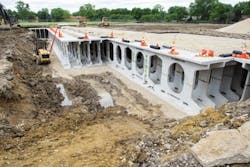About the author: Allison Fore is public and intergovernmental affairs officer for the Metropolitan Water Reclamation District of Greater Chicago. Fore can be reached at [email protected] or 312.751.6626.
The value of rainwater varies throughout the world, but when it floods a basement, inundates streets and parks, and overwhelms sewer systems, the worth of that water plummets. A community located 2 miles from Lake Michigan with areas that regularly flood during storms has changed its opinion about storm water thanks to a project that not only prevents flooding, but also supports a park and enhances a neighborhood.
Rising Waters
The village of Northbrook, Ill., is sandwiched between the Des Plaines and Skokie rivers. With the West Fork of the North Branch of the Chicago River running through the village, water is a plentiful asset. However, when it rains, storm water overwhelms the community’s flat terrain. With an increase in frequency of intense rain events and increased impervious pavement, parts of the village succumb to flooding.
The Sunset Fields subdivision in central Northbrook was platted in the 1950s, prior to modern-day storm water drainage and detention requirements. Storm sewers were undersized, suitable overland flow paths were lacking and storm water detention was not provided. During heavy storms, homeowners in the subdivision report flooded basements, and local roads were inundated with water.
Northbrook’s Stormwater Management Commission joined village staff and the board of trustees to identify public infrastructure projects that would help reduce flooding impacts within the community. They developed a master storm water management plan, and between 2011 and 2012 generated 28 projects. Some of these have been built and others are planned for the future. One of these projects, Wescott Park, located in Sunset Fields, stood out because a number of properties were impacted by flooding in the neighborhood. Faced with the challenges of flooding, updating and maintaining the park, the village of Northbrook sought a way to use every inch of this park space—and then some. The village teamed up with the Metropolitan Water Reclamation District of Greater Chicago (MWRD) and the Northbrook Park District to create a rainwater harvesting system that alleviates flooding while collecting the water to refresh new park grounds. Through this system, officials could add a layer of protection that serves a useful purpose while supporting a dramatic facelift to the park.
Finished Product
After 13 months of engineering and eight months of construction, the new Wescott Park opened in November 2016, providing 7.7 million gal (23.7 acre-ft) of storage capacity, equivalent to more than 11 Olympic-sized swimming pools. The project consists of a new storm sewer to supplement the existing sewer, 4,730 sq yd of concrete street pavement for about 1,500 ft of street reconstruction, and construction of a storm water chamber underneath the north half of the park. Along with associated storm sewer improvements, the project will reduce the frequency and severity of flooding while benefitting downstream neighborhoods. The $9.65 million Wescott Park Stormwater Facility also includes park upgrades, such as an attractive ball field, a bike path, landscaping, and nearly 70 new trees and 50 shrubs. Yet it is what visitors cannot see—the storm water chamber below the surface—that is receiving accolades.
“This project is a major victory for Northbrook. Not only can they better improve their quality of life in building protection from flooding, but they are also recovering and conserving vital water resources that can be harvested and reused to maintain park grounds,” said MWRD Board of Commissioners President Mariyana Spyropoulos.
The new storm water chamber, which required approximately 15,000 cu yd of concrete to construct, is one of the largest of its kind in Illinois. In addition to enabling the park district to irrigate the ball fields, it also allows the village to capture rainwater and reuse a portion of what is stored for irrigation, maintaining parkway trees, and cleaning streets and sewers. The project also reduces the storm water flow to the North Branch of the Chicago River.
“One of my first priorities upon being elected village president was to improve the conditions of those who were affected by flooding in Northbrook,” said Northbrook Village President Sandy Frum. “The Wescott Park Stormwater Facility is a prime example of what can be accomplished when governmental agencies work together for the benefit of a community.”
Rewarding Results
A designated utility of the future, MWRD is not only treating an average of 1.4 billion gal of wastewater per day to protect water sources and manage storm water for the region, but also is recovering vital resources. Among the resources recovered in the treatment process are energy, algae, phosphorus and biosolids used as a sustainable fertilizer for public use. Through partnerships, MWRD plans to supply 10 million gal of treated water per day for industrial use. In addition to being harnessed, water itself is reused directly through the MWRD treatment process. Every day, 15.1 million gal are reused at MWRD plants for pipeline flushing, blower motor cooling, post-centrifuge centrate flushing and tank cleaning.


